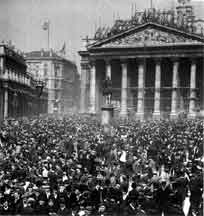1902 South African Peace Agreement

Celebration in London
On May 31st 1902 the Boers and the British signed the Peace of Vereeniging. The agreement was an acknowledgement of what was already a fact: British rule over South Africa..
On May 31st, 1902, representatives of the Boers and the British Empire sat down in the dusty town of Vereeniging to put an end to one of the most grueling wars of the late 19th and early 20th centuries: The Second Anglo-Boer War. The document they would produce, known as the Peace of Vereeniging, was more than a mere treaty. It was a recognition of a new political reality: the consolidation of British dominion over the entirety of South Africa.
The war had been brutal, characterized not only by major battles but also by guerrilla warfare, concentration camps, and the scorched earth policy. It had been costly for both the British Empire and the two Boer republics—the South African Republic (Transvaal) and the Orange Free State. The British, despite their superior numbers and resources, had found it hard to deal with the guerrilla tactics of the Boer fighters. Conversely, the Boers, fiercely independent and determined to maintain their sovereignty, were beleaguered by the overwhelming force and advanced tactics of the British Empire.
The Peace of Vereeniging marked a turning point in the trajectory of South African history. While the document made provisions for the end of hostilities and the British payment of war reparations to the Boers, its most significant feature was the formal annexation of the Boer republics into the British Empire. This meant the end of the Boer dream for independent republics in the southern tip of Africa.
The treaty also addressed several immediate post-war concerns. Civil rights would be guaranteed for all white inhabitants, but the rights of the black majority were, disappointingly, relegated to future self-government discussions. This omission was telling; it laid the groundwork for the racial disparities that would mar South African society for the next century.
The absorption of the Boer republics paved the way for the unification of South Africa under British rule in 1910. This was a significant development. The British had not only secured valuable diamond and gold resources but had also achieved a strategic geopolitical objective: a unified colony in a critical maritime location, further strengthening the Empire's global reach.
However, the consequences of the Peace of Vereeniging extended beyond the immediate geopolitical gains for the British Empire. In the decades that followed, the merger of British imperial traditions with Boer values, culture, and governance structures would give rise to a unique South African identity—one that was rooted in European colonialism, yet distinct in its evolution.
The Afrikaners, descendants of the Boers, would gradually come to dominate South African politics and society. Their sense of identity, molded by the experiences of the Anglo-Boer wars, combined with a deep-seated belief in their divine right to the land, would culminate in the establishment of apartheid—a policy of racial segregation and discrimination—in 1948.
In retrospect, the Peace of Vereeniging stands as a watershed moment in South African history. It signaled the formal end of Boer independence, but it also set the stage for a complex interplay of cultures, identities, and politics. The ramifications of this treaty would shape the socio-political landscape of the region for decades, making it a foundational document in understanding modern South Africa.
 >
>